News Briefs
Read a roundup of stories featuring alumni and student achievement, faculty research, and college milestones.
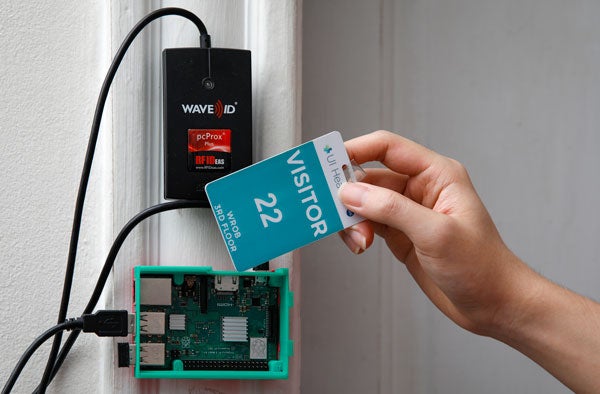
Beyond pen and paper
When COVID-19 patients began arriving at UI Health, the hospital’s administrators needed a way to track their workers’ potential exposure to the transmissible virus. The system they had wasn’t ideal: a paper sign-in sheet posted on each coronavirus patient’s door, on which hospital staff handwrote their names for a colleague to later decipher and record in a database.
Enter UIC’s electrical and computer engineering department—and RFID technology. Associate Professor Alan Feinerman and undergraduate student Zhongyi Chen knew that UI Health owned RFID readers, for “radio frequency identification,” that would be used in a forthcoming electronic medical records system. Feinerman and Chen thought to press them into service during the pandemic.
Chen took the lead in designing a system that ultimately included 22 door-mounted trackers. The system records the name of each employee who enters a tracker-equipped room, along with the time and date. A light flashes when staff members’ tags are scanned to let them know their data have been successfully collected. The system provided for data storage and had a data-recovery plan. All of this was made available to UI Health for potential implementation.
What Chen was able to develop from existing parts—the hospital’s RFID readers, scannable stickers, Raspberry Pis borrowed from the ECE Tinkering Program, and other materials on hand—is a creative alternative to commercial tracking systems, which can be cost-prohibitive, or software that must be installed on people’s personal cell phones, which can feel invasive. It was a way in which Chen, Feinerman, and their collaborators were happy to contribute.
“When they asked for help, we wanted to make sure we answered,” Feinerman said.
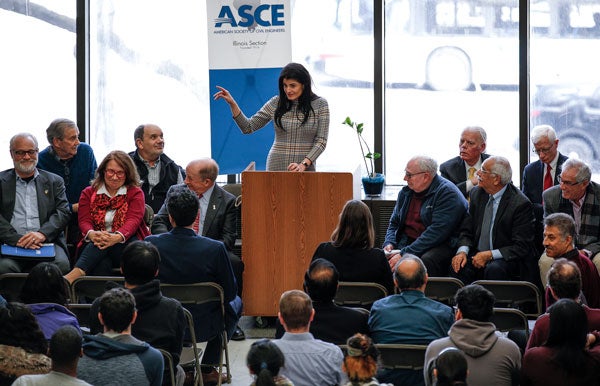
Learning from legends
It’s gratifying to be able to look at a national program and say, “This started at UIC Engineering.”
That’s an experience that Michelle Calcagno, BS ’20, is likely to have in a few years. She is the creator of a new American Society of Civil Engineers program called ASCE Legends, which pairs experienced retired civil engineers (the “Legends”) with students and early-career professionals. Calcagno developed a pilot of the program at UIC, and the national organization recognized it as a way for engineers to pass on their expertise, experiences, and wisdom. It may one day expand far beyond Chicago.
The benefits of mentorship to students are clear. As Calcagno puts it: “A mentor eases the stress of navigating the uncharted path on your own.” But the ASCE Legends program is unique in how it helps retired engineers, too. Sharing knowledge and stories, connecting with younger generations, and staying connected to the field can provide retirees with a new sense of meaning and fresh perspective.
With the program launch completed this spring, the next step is to do what engineers do best: evaluate and build on it to make it better.
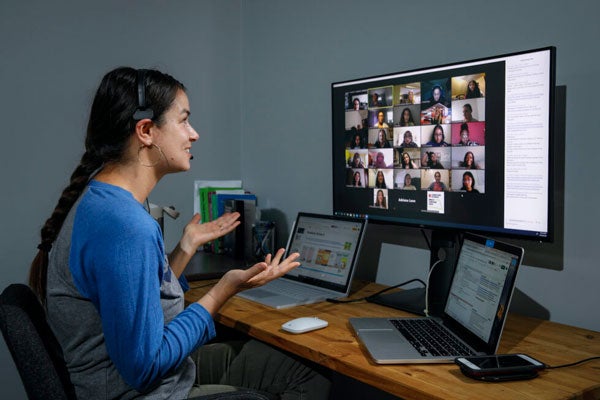
Is CS for me?
They created gaming apps. They simulated the path of information through a network. They discussed possible threats to the security of their private information, from cyber criminals to roommates. At the end of the four weeks of CS 100, they had a much better grasp of computer science: what it is and how it might figure into their future.
These 20 students were the initial participants in a Break Through Tech Chicago section of the computer science department’s introductory course for non-majors, offered to undergraduates in UIC’s College of Liberal Arts and Sciences. Break Through Tech Chicago, housed in the computer science department of UIC Engineering, seeks to increase the presence of women in tech careers by giving them the computer science education they need to succeed. Through Break Through Tech, tech-curious students can experiment with CS 100 and other programs at no cost.
Not all participants were certain by the end of CS 100 that computer science is for them, but one-third expressed interest in either a major or a minor. Others simply reported broadened horizons. “CS 100 made me learn that I should expose myself to learning more skills, even skills that I think I do not need for my career,” one student said. “It convinced me to explore more introductory classes and possibly the CS path.”

Safety in health and data
Digital contact tracing is a simple idea. A device, such as a cell phone, notes whom its owner encounters by making Bluetooth connections with nearby phones. When a person tests positive for a virus, the recorded contacts can be notified and warned. In an age of increased cyberattacks, the more complex aspect is: How can digital contact tracing be done while preserving people’s privacy?
Researchers are suggesting enhancements to contact-tracing apps that incorporate security features similar to the ones used in banking and financial trading. The work is being conducted by a team that includes Venkat Venkatakrishnan, a UIC professor of computer science and the interim director of research at Discovery Partners Institute.
Their framework, which relies heavily on cryptography, makes contact data anonymous so that interactions are untraceable. Users’ privacy is better protected by keeping their identities hidden from multiple parties: the app and the server that computes positive contacts, government entities that track cases, healthcare providers that report illness, and external attackers.
To use an app like this, a person would set up an account, which generates a unique, secret key. The key would then create individual ephemeral IDs to beam to nearby users. For additional security, a cryptographic hash or code would link to the IDs, adding a time and location stamp to the interaction through a mechanism called context signature verification, or CSV. This way, if a system user were notified of a potential exposure, the app would first verify that the CSV of the virus-positive individual matched their own—preventing the phenomenon of false alerts generated by hackers.
Venkatakrishnan and the team have proposed their architecture and set of mechanisms to industry groups through the Discovery Partners Institute.
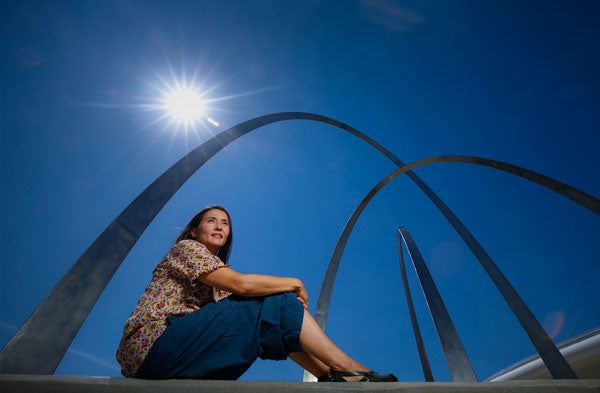
Growing the 14 percent
Women make up 47 percent of the U.S. workforce but only 14 percent of engineers, according to the American Society of Mechanical Engineers. Two faculty members in the Richard and Loan Hill Department of Bioengineering are gaining attention for their efforts to change that.
Associate Professor Ramille Shah is one of 10 influential women in engineering named this year by the American Society of Mechanical Engineers. She shares the list with NASA astronaut Christina Koch; Gwynne Shotwell, the president and chief operating officer of SpaceX; and Evelyn Wang of MIT. In addition to teaching at UIC and leading a research laboratory, Shah is co-founder and chief scientific officer of Dimension Inx, a company that 3D-prints and manufactures custom biomaterials. These materials can be used to regenerate tissue that is damaged from illness or injury.
Just a few months after Shah’s honor, her colleague Miiri Kotche, clinical professor of bioengineering, made the “Notable Women in STEM” list published by Crain’s Chicago Business. Kotche goes above and beyond to help her students see pathways to careers in engineering and medicine. She helps to lead the Freshman Engineering Success Program, runs a clinical immersion program that gives students firsthand experience in a medical environment, and works with UIC Medicine on the Innovation Medicine Program, which aims to produce physicians who can solve clinical problems with creativity and technology.
“Looking back at my own education, I can remember how few women were in my classes, and even fewer were taught by women,” Kotche said. “I want to help represent women as a role model. Not just for our female students, but also for our male students, so they can see a female in a role-model situation.”
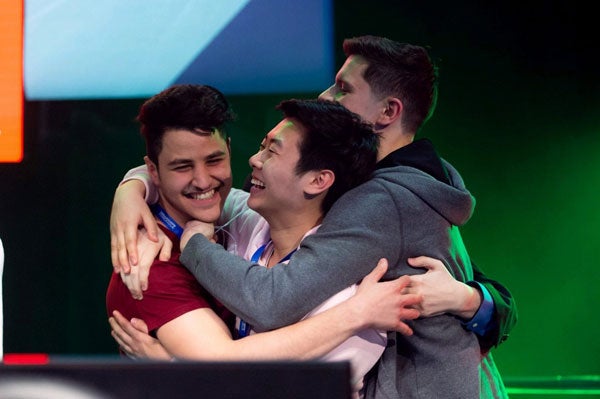
Game to win
The world of competitive video gaming is tremendously popular, so it makes sense that UIC’s Competitive Gaming Club has more than 350 student members. Five of them—including computer science major Nikita Mashchenko and recent graduates Michael Lederer and Michael Pekala, both BS ’20—won first place and $20,000 in a recent Collegiate StarLeague competition.
The UIC team competed in Dota 2, a multiplayer online battle arena video game played in head-to-head matches of five-player teams. UIC’s Dota 2 team rose up the ranks in just three seasons, winning second place in the StarLeague last year before moving on to victory. The crux of Dota 2 is strategy, as players work from a home base to challenge one another using characters that have various strengths and weaknesses.
“A lot of the strategy comes in where you have to figure out how to draft a good lineup of characters that work well together and work well against the enemy characters,” Lederer said. “Then the objective is sort of like capture the flag, where you have to work your way up to get stronger every game and destroy the main structure of the enemies’ base.”
He added, “If you told me three years ago, ‘Hey, you’re going to put together a team and you’re going to get second place after one season, and then the season after that you’re going to get first place and you’re going to win $20,000,’ I’d call you crazy.”

1,800 miles to class
Volunteering can make a difference in a couple of ways: by helping the community being served and by having a positive impact on the volunteer who serves. Quintin Williams Jr., a clinical assistant professor in industrial engineering, points to an additional dimension: lessons from his volunteer experience in Haiti often benefit the students in his classroom.
Williams, who has volunteered with MedGroup HAITI from Université Lumière for three years, uses his industrial engineering expertise to help with some of Haiti’s primary health and safety concerns. After earthquakes and hurricanes, he has worked with local engineers to build safer structures. He has re-engineered villages’ sanitation methods, and he has helped to integrate public-health education on environmental and occupational safety topics into the nursing curriculum at Université Épiscopale d’Haïti in Léogâne.
At UIC, Williams shares these projects with his students, using them as examples to teach about structural and safety engineering and the laws that govern the way things are built. “Haiti doesn’t have the same structure,” Williams said. “It’s a good example of how the U.S. system of operation for building codes is logistically necessary when it comes to having structures that can survive natural disasters.”
Aly ElBanna, a master’s student in industrial engineering who took Williams’ course on production planning and inventory control, said he’s inspired by his teacher. “I have had the privilege of hearing about the importance of applying our industrial engineering skill set for the greater good,” he said. “Cross-cultural examples like these allow students like me to expand our thought process beyond the justification of the modus operandi currently used in the United States.”
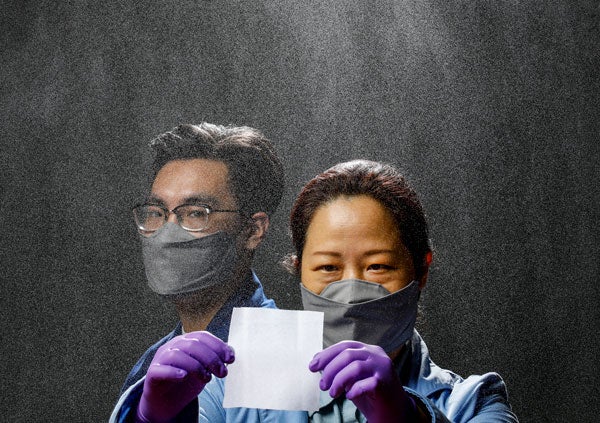
Mask, rinse, repeat
Peer into a petri dish of virus particles and you’ll most likely find that they’re nanoscopic in size, ranging from a few nanometers to 100. A conventional N95 face mask, while it provides some protection, uses a filter designed to screen out microparticles, which are 1,000 times larger. This is the dilemma that Sangil Kim, assistant professor of chemical engineering, is working to solve.
Kim and his team in the Molecular Transports in Nanopores Laboratory are developing a viral-filtration mask that can ward off even the smallest nanoparticles. The mask features a nanofibrous filter, which has smaller pore sizes and a higher surface area. It also has high porosity (or empty space), which increases air flux, making the mask more breathable.
In addition to providing stronger protection and better comfort than a conventional N95, Kim’s group’s mask doesn’t rely on electrostatic interaction between viral particles and filter materials, making it washable and reusable—an important feature in reducing waste and supply shortages.
Kim’s team also is working with Associate Professor Gang Cheng to design a more powerful filter for a novel multifunctional respirator. The filter has high breathability, self-cleaning capabilities, and can capture and kill viral particles—a combination of features that current respirators and medical masks, such as the N95, cannot provide.